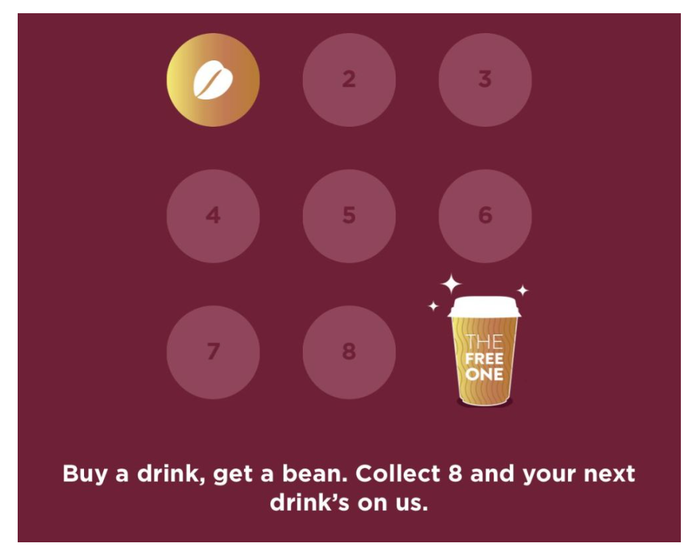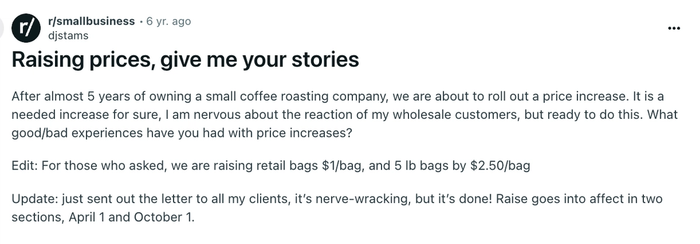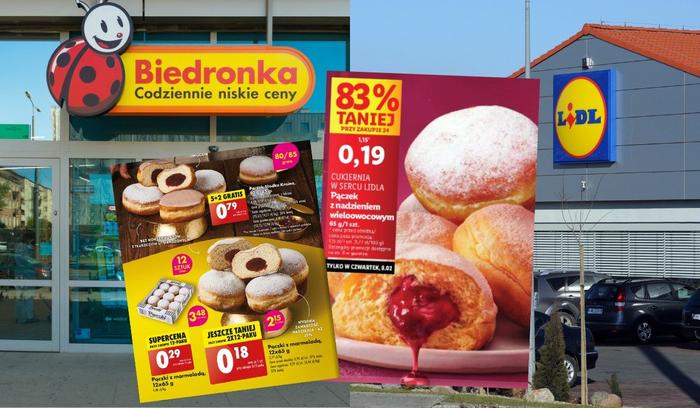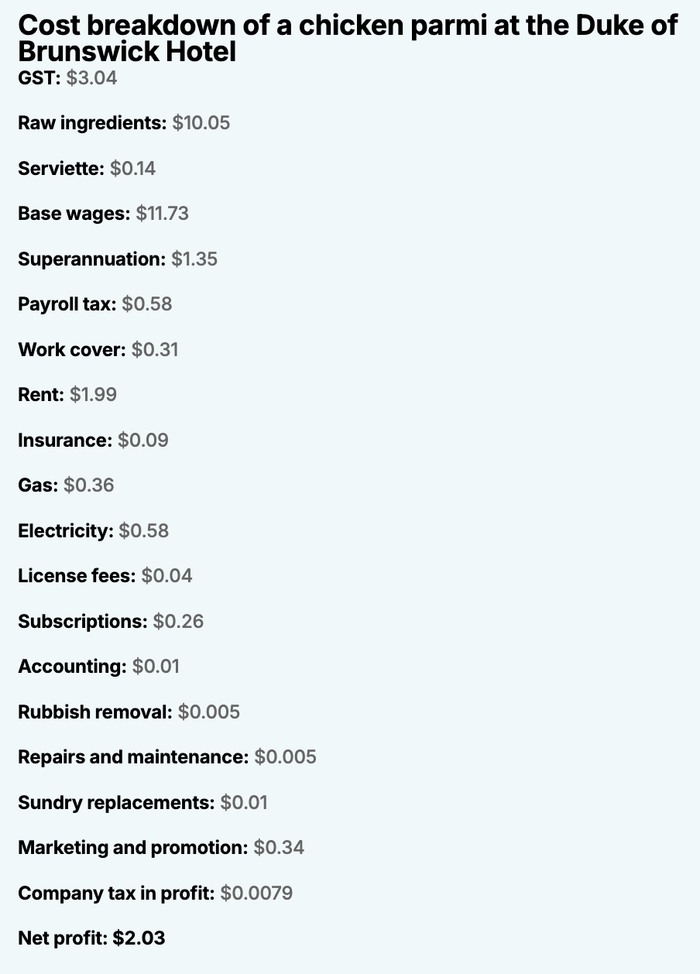Pricing can feel like a guessing game. Charge too much, and customers might walk away. Charge too little, and you could be working for nothing. The reality? Most small business owners undervalue their work and leave money on the table.
Fortunately, you don’t need a finance degree to set the right price. Whether you sell products or services, pricing is about two things: covering your costs and making sure customers see the value in what you offer.
In this guide, we’ll break down simple pricing strategies that help you set fair, profitable prices – without second-guessing every number.
Why pricing deserves your attention
If you’ve ever felt too guilty to raise prices or worried about scaring off customers, you’re not alone. Many small business owners guess at pricing—only to find themselves working harder than ever but barely seeing the rewards.
The upside of confident pricing
You attract better customers. People who value quality over just the lowest price will be willing to pay for what you offer.
You make smarter decisions. When you know your numbers, you can afford to reinvest in growth instead of constantly chasing sales to stay afloat.
You finally pay yourself what you deserve. Many small business owners struggle to pay themselves a decent salary – good pricing helps fix that.
The hidden costs of bad pricing
Underpricing makes you work harder for less. Let’s say you run a bakery and price your cakes at $30 each. You sell 10 cakes daily and think you’re doing well – until you realize that after ingredient costs, rent, and labor, you’re making just $5 per cake. That’s not enough to sustain your business, and you’re burning out.
Overpricing without a strategy can kill sales. On the other hand, if you price that same cake at $100 without a clear reason, customers will compare you to competitors and walk away. If they don’t see the value, they won’t pay the price.
Ignoring pricing means leaving money on the table. Even a small price increase (like 10%) can increase your revenue without needing more customers. Imagine selling 100 cakes at $35 instead of $30 – that’s $350 extra for the same work.
Your pricing shouldn’t just keep the lights on – it should fuel your growth.
How to calculate the right price for your business
Step 1: Cover your costs
If you’re not covering all expenses, you’re not running a business - you’re funding a hobby.
Formula for product pricing:Price = (production costs + overhead costs) + desired profit margin
Example:A handmade candle costs $5 to produce, with $2 overhead (marketing, packaging, etc.). If you want a 50% profit margin, the selling price should be:($5 + $2) + (50% of $7) = $10.50 per candle
You can use this profit margin calculator from Shopify to set your product pricing:
https://www.shopify.com/tools/profit-margin-calculator
Formula for service pricing:Hourly rate = (desired annual income + business expenses) ÷ billable hours
Example:A freelance designer wants to earn $80,000/year with $10,000 in expenses. They work 30 hours per week:($80,000 + $10,000) ÷ (30 hours × 52 weeks) = $57.69/hour
You can also use this simple calculator from Clockify to calculate your hourly rate:
https://clockify.me/hourly-rate-calculator
Step 2: Get to know the market
Do you know what people are willing to pay for products or services like yours? Your price needs to make sense in your industry. If it’s too low, customers question quality. If it’s too high without justification, they go elsewhere.
How to check if your price is realistic:
- Look at competitors – are they charging 20-30% more or less than you?
- Survey your customers – would they pay slightly more for added value?
- Check demand – are people hesitant at checkout or saying "that’s a bargain"?
Step 3: Handle discounts the right way
Many small business owners use discounts as a quick fix – but constant discounting can do more harm than good. If you always lower your prices, customers will expect it and never pay full price.
When discounting is a mistake?
- Customers wait for sales instead of buying at regular prices.
- It lowers perceived value – if it’s always discounted, is it even worth the full price?
- It shrinks margins – cutting 20% off a $100 service means you need 25% more sales just to break even.
How to discount the smart way?
- Offer bonuses instead of discounts – “Buy X, get Y free” makes customers feel like they’re getting extra value.
- Use urgency-based discounts – limited-time offers should be rare to keep them effective.
- Create VIP pricing – give exclusive discounts to loyal customers, not just anyone.
Instead of offering blanket discounts, test a loyalty program – reward repeat customers with perks instead of cutting prices for everyone.
That’s exactly what Costa Coffee does. Customers collect stamps for each purchase and can exchange 8 stamps for a free drink. This encourages repeat business without devaluing the product:

Step 4: price with confidence
Even if your pricing is spot-on, how you communicate it matters just as much. Many small business owners hesitate to show their prices or get nervous when customers push back.
You shouldn’t:
- Hide prices – If customers don’t see pricing, they assume it’s too expensive.
- Talk about price as a cost, not a value – “It costs $500” vs. “You get X, Y, and Z for $500.”
- Sound uncertain – If you second-guess your price, your customers will as well. Own your value.
- Waver on cost – If you don’t present your price with certainty, customers may assume it’s negotiable.
How to make your price feel right to customers?
- Be upfront about pricing - if it’s fair, there’s nothing to hide.
- Frame it as an investment - “You get [specific benefit] for [price]” instead of just listing the cost.
- Use a comparison anchor - “This coaching costs less than 2 takeout coffees per day.”
- Have a response for “too expensive” - instead of lowering price, explain what makes your offer different from cheaper alternatives.
Practice saying your price with confidence. Instead of apologizing or over-explaining, say: “This package is $1,500, and here’s what you get.” No hesitation, no justification.
Signs you might be underpricing or overpricing
Are you underpricing?
- Customers rarely negotiate or question your rates.
- You’re working more but not earning more.
- People assume your service/product is low quality.
What to do:
- Test a small price increase (e.g., 15%) and see if demand stays the same.
- Offer a premium version of your service to gauge interest.
- Highlight value, not just price – show results, quality, and benefits.
Holding off on raising your prices? It could be hurting your business. A small coffee roasting company kept the same prices for nearly five years, afraid of losing customers.

But when they finally increased their prices to reflect rising costs, they found that loyal customers stuck around – and the business became more sustainable.
Are you overpricing?
- You get lots of interest but few actual purchases.
- Customers constantly ask for discounts or try to negotiate.
- Competitors with similar offerings sell faster.
What to do:
- Try promotional pricing (limited-time offers) to test demand.
- Offer bonuses instead of discounts (e.g., extra features, free delivery).
- Improve perceived value – do people understand why your price is higher?
Before you pick a pricing strategy…
You now have a starting price, an idea of what customers are willing to pay, and signs to watch for overpricing or underpricing. From here, you can fine-tune your pricing strategy to attract the right customers while staying profitable.
Common pricing strategies
Cost-plus pricing (baseline pricing)
A straightforward pricing method: add up your costs, apply a markup, and get your price. It guarantees profitability but doesn’t consider customer demand or perceived value.
Best for:
- Businesses with fixed production costs (e.g., printing companies, marketing agencies with set packages, product-based businesses).
- Small business owners who want a predictable, simple pricing model.
How to price smarter:
Step 1: Start with cost-plus as your foundation.Calculate your production + overhead costs and add a realistic markup.
Step 2: Compare to competitors.Are similar businesses charging 20-40% more? You may be underpricing.
Step 3: Test price increases.Raise rates by 10% for new clients and monitor conversions. If demand stays steady, you’ve found pricing power!
Example: A small marketing agency in Newark
A marketing agency sets up social media management packages. Their basic plan costs $800 to fulfill (including labor, tools, and overhead), so they apply a 50% markup and set the price at $1,200.
What went wrong?
- They assumed this price was enough – until they checked competitors and found similar services priced between $1,500–$2,000.
- Clients didn’t just buy social media posts. They paid for strategy, engagement, and conversions.
- They were attracting small businesses with low budgets, but they wanted mid-sized brands willing to invest in growth.
How they fixed it?
- They adjusted their price to $1,500, highlighting ROI (higher engagement, better ad performance, more leads) in sales calls.
- They introduced tiered pricing – a basic package at $1,200 and a premium package at $2,000 with additional ad strategy consulting.
- They surveyed their best clients, asking: “What made you choose us over others?” and used those insights to reposition their pricing.
Value-based pricing
Instead of just covering expenses, value-based pricing focuses on what customers are willing to pay based on the benefits they receive. If your service or product saves time, increases revenue, or delivers premium quality, you can price accordingly.
Best for:
- Service providers (consultants, agencies, freelancers) who offer expertise, custom solutions, or high-impact results.
- Businesses with strong branding or differentiation (e.g., premium skincare, boutique fitness studios).
- Businesses that solve a painful or high-stakes problem (e.g., legal services, copywriting for sales pages).
How to price smarter:
Step 1: Identify the results you deliver.
- Does your product or service save customers money?
- Does it increase their revenue, efficiency, or quality of life?
- Can you back this up with case studies or customer success stories?
Step 2: Check what customers are willing to pay.
- Look at competitors charging premium prices—what makes their offer stand out?
- Survey or test different pricing tiers to see customer reactions.
Step 3: Frame your pricing as an investment, not an expense.
- Instead of saying, “Our service costs $3,000,” say: “Clients who invest in our service see an average 3x ROI within three months.”
- Show them the transformation—how does their before vs. after look when they work with you?
- You should justify your pricing. If you can’t communicate the results customers get, they may see your price as "expensive" instead of "worth it."
Value-based pricing really works. Rachel and Marcus Dillon, owners of a CPA firm, moved away from hourly billing and shifted to value-based pricing. They introduced evergreen engagement letters and clearly communicated pricing changes to clients. Now, their pricing better reflects their expertise, and they increased their revenue per client – without losing customers.
Example: A copywriter in San Diego
A freelance copywriter used to charge $500 for a sales page. Their clients, however, reported earning $50,000+ from the copy. Clearly, they were underpricing.
What went wrong?
- They based pricing on time spent (a few hours) instead of the revenue impact they created.
- Clients saw their service as a commodity rather than a high-ROI investment.
- They attracted price-sensitive buyers instead of business owners willing to invest in high-converting copy.
How they fixed it:
- They repositioned their offer, stating: "High-converting sales copy that can generate 5-10x ROI."
- Instead of hourly pricing, they bundled services into premium packages – for example: $1,500 for a sales page only and $5,000 for full funnel copy and a strategy session.
- They showcased client success stories with hard numbers – e.g., “This sales page helped [Client Name] generate $75,000 in course sales.”
If customers hesitate at your pricing, don’t lower your rates – increase the perceived value. Add bonuses or extra support that makes it a no-brainer investment.
Competitive pricing
Competitive pricing means setting your price based on what others in your industry charge rather than just your costs or perceived value. It’s about positioning – are you a budget-friendly option, a premium choice, or somewhere in between?
Best for:
- Businesses in crowded markets where customers compare prices before buying (e.g., marketing agencies, SaaS companies, fitness trainers, plumbers, e-commerce stores).
- Service providers who want to align pricing with customer expectations but differentiate through features, service, or expertise.
How to price smarter:
Step 1: Identify where you stand in the market.
- Are you a budget-friendly option for startups?
- A premium choice for high-end clients?
- The best balance of price vs. value in your niche?
Step 2: Research competitor pricing – but don’t copy.
- Look at 3-5 competitors in your niche. What do they charge, and what’s included?
- Are they underpricing? Do they rely on upsells? Are they actually profitable?
Step 3: Avoid the "race to the bottom."
Many small business owners blindly copy competitors’ prices without considering their own costs, expertise, or differentiation. This leads to:
- Pricing too low – Cutting margins to “stay competitive” can hurt profitability long-term.
- Blending in – If your price matches competitors but your value isn’t clear, customers may see you as just another option.
- A price war – Undercutting competitors can trigger a war where no one wins – except bargain-hunters who aren’t loyal. This happens often, especially during big retail events such as Black Friday.
One particularly funny example comes from Poland, where two supermarket giants, Lidl and Biedronka, got into a battle over who could sell the cheapest doughnuts on Fat Thursday (a major Polish holiday). Lidl set their price at 0.19 PLN ($0.04, yes, you read it right). Biedronka responded by dropping theirs to 0.18 PLN.
Who won? Maybe Biedronka – but in reality, both likely lost. Why? Because customers weren’t buying those doughnuts at normal prices anyway, and such extreme discounting only attracted deal hunters, not loyal customers.

Step 4: Justify your pricing with a unique edge.
- If you charge more than competitors, make sure customers see the added value (better service, more expertise, faster results).
- If you charge less, be strategic - low pricing should be a market entry move, not a survival tactic.
Always highlight why your offer is better. Better service, better results, and better experience justify a higher price.
Example: A small online shop in Miami
A small handmade jewelry store sells handcrafted silver rings online. At first, they priced their rings at $30 each, thinking they had to stay competitive with mass-produced alternatives. However, they noticed that similar handcrafted rings on Etsy and independent online stores were selling for $50–$80.
What went wrong?
- They set their prices based on what big-box retailers charge rather than the handmade market standard.
- Customers assumed the quality was lower because the price was too low compared to competitors.
- They positioned themselves as a budget brand instead of a high-quality, artisanal option.
How they fixed it:
- They researched competitors’ pricing and realized their craftsmanship, materials, and unique designs justified a mid-to-premium price point.
- They repositioned their branding to emphasize quality: "Handcrafted, sterling silver rings made to last a lifetime—without the mass-market markup."
- They adjusted their pricing strategy. Instead of undercutting competitors, they aligned with market expectations and set prices between $55–$75.
- They highlighted their competitive advantage. Instead of trying to compete on price, they emphasized their unique designs, ethical materials, and handmade quality.
- They added social proof – “Over 500+ five-star reviews from happy customers.”
Psychological pricing
Pricing is largely about how those numbers feel to customers. Psychological pricing taps into buyer behavior to make your price seem more attractive without changing its actual value.
Best for:
- Small businesses selling online or in-store.
- Service providers looking to increase perceived value.
- Businesses running promotions or limited-time offers.
How to price smarter?
Step 1: Use charm pricing strategically.
- $99.99 feels cheaper than $100, even though it’s a one-cent difference. This works well for budget-friendly products.
- Premium brands often prefer rounded numbers ($500 vs. $499) to reinforce quality over cost.
Step 2: Anchor prices to make deals look better.
- Displaying a higher “original” price next to the discounted one makes the new price feel like a bargain. However, If you manipulate pricing too much (e.g., fake discounts), you risk losing trust.
- Example: A course originally priced at $399, now available for $249 – suddenly, $249 feels like a steal. Don’t overuse it, though – if customers expect sales all the time, they may never pay full price.
Step 3: Bundle products/services together.
- A $120 service feels expensive, but a "3-session package for $299" feels like a deal.
- Bundling works for coaching, beauty services, and SaaS plans, where perceived savings boost conversions.
Example: A small skincare brand
A small skincare brand sells handmade organic face creams online. Initially, they priced their best-selling moisturizer at $35, but they noticed customers hesitating at checkout. Instead of lowering the price, they used psychological pricing tactics to encourage more conversions.
What went wrong?
- The price point felt random and didn't take advantage of buyer psychology.
- There was no reference price – customers had no anchor to compare if $35 was a good deal.
- They only had a single purchase option, limiting how much customers spent.
How they fixed it?
- They used charm pricing. Adjusting the price to $34.99 led to a higher checkout conversion rate without reducing revenue.
- Instead of just listing the price, they crossed out $50 (a suggested retail price) and displayed "Now only $34.99", creating the perception of a discount.
- Instead of selling only individual jars, they introduced a bundle deal – with two ars for $64.99 instead of $69.98, and three jars for $69.99 (“Buy 1, get 1 free). The highest-tier option encouraged customers to buy more at once, increasing average order value.
If you sell products or services, test one small psychological tweak – whether it’s charm pricing, bundling, or price anchoring – to see if it influences sales!
Bonus: How to raise prices without losing customers
A huge concern for small business owners: "If I raise prices, I’ll lose customers." You could take a practical approach to increasing prices without scaring people away:
- Step up your value before the increase – improve service, add small extras, and get testimonials.
- Communicate clearly – instead of “our prices are going up,” say “we’ve added more value and expertise to deliver better results.”
Worried about customers pushing back on your prices? Transparency is key. Simone Douglas, owner of The Duke of Brunswick Hotel in Adelaide, faced criticism for a $33 chicken parmigiana. Instead of lowering the price, she explained the reality: rising costs of ingredients, wages, and rent meant minimal profit margins.

The result? Customers gained a new appreciation for what goes into pricing—and her business stayed sustainable.
- Raise prices in stages – test small increases rather than doubling prices overnight.Give existing customers a grace period – “Lock in current rates for the next 3 months before we adjust pricing.”
Over to you
Many small business owners hesitate to charge what they’re worth, fearing they’ll lose customers. But pricing isn’t just about numbers – it’s about value. The right price should reflect your expertise, effort, and the impact you bring to customers.
The biggest mistake? Undervaluing yourself. A business that earns well, grows well. Charge fairly, stand by your pricing, and give customers a clear reason to choose you!




